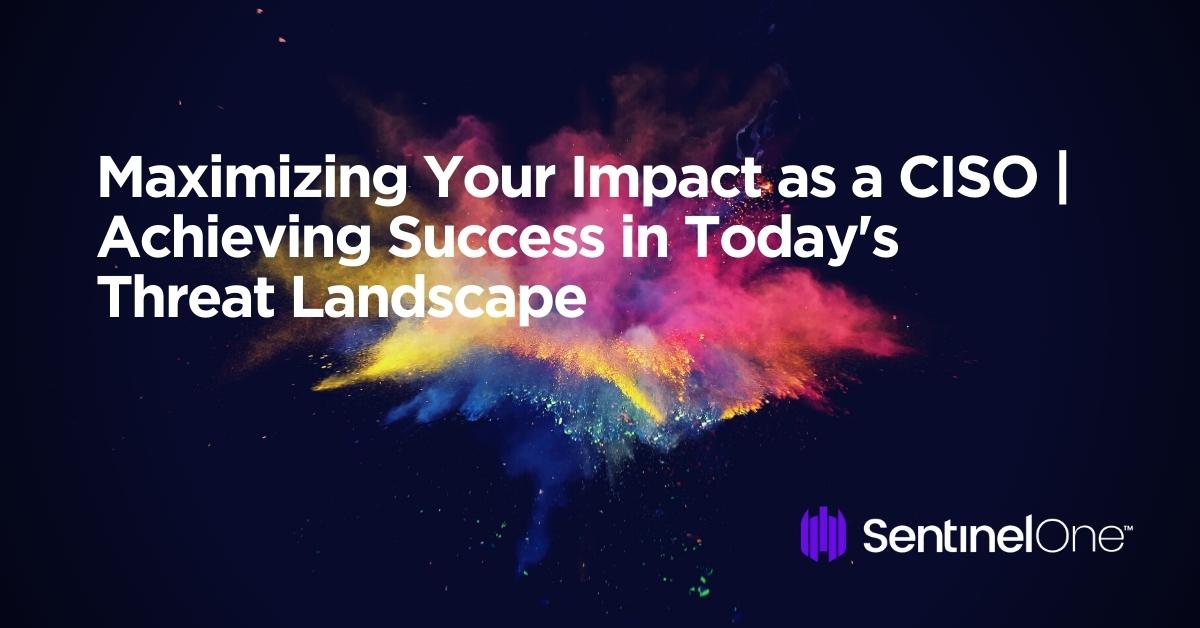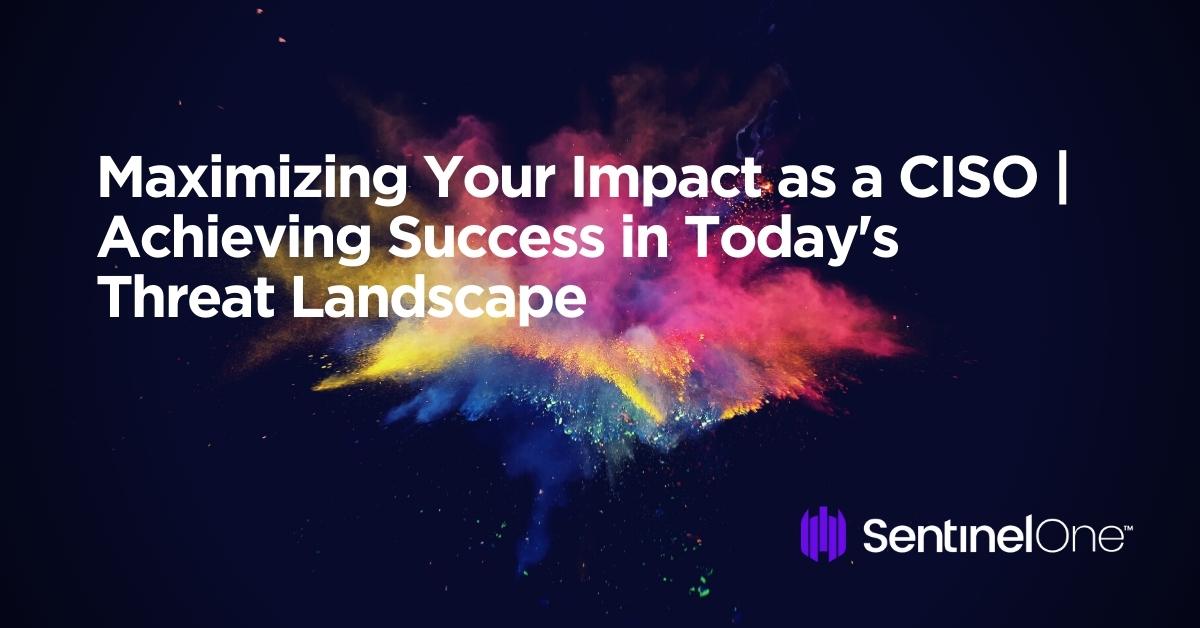
2023-1-3 23:20:25 Author: www.sentinelone.com(查看原文) 阅读量:23 收藏
Cybersecurity continues to transform, leading to an evolution of what makes a successful Chief Information Security Officer (CISO). Once, the role focused on championing the implementation of digital security strategies. In today’s threat landscape, though, successful CISOs have added to their focus the mantle of risk manager and communicator. CISOs that can identify risks and share them effectively and in an actionable way can better direct their organization to a more resilient cybersecurity posture.
A CISO’s capabilities directly affect the short and long-term security of their organization. To find success in this role, CISOs in the current cyber climate must find a balance between five main areas:
- Risk management
- Strategic communication
- Leadership through open communication
- Continuous learning
- Security expertise

How CISOs Protect Against Modern Cyber Threats
A successful CISO is a critical element of any organization’s leadership team. In today’s digital landscape, where cyber threats are constantly evolving and data breaches can have disastrous consequences, a strong and effective CISO is essential for protecting an organization’s information and assets. With the increasing prevalence and sophistication of cyberattacks, having a dedicated and skilled CISO is essential for ensuring that an organization’s sensitive data and systems are secure.
CISOs are not only instrumental in implementing and managing the organization’s cybersecurity strategy but also ensure that the organization’s employees are aware of cybersecurity best practices and protocols and are trained to identify and mitigate potential threats.
Acting as a link between employees and senior leadership and stakeholders, CISOs are responsible for communicating effectively with both groups about the organization’s cybersecurity posture. This includes providing regular updates on the effectiveness of security measures and any potential risks and vulnerabilities that may need to be addressed.
Adaptability Is Key | Why the Role of CISOs Has Changed
The role of a CISO has changed significantly in response to the evolving cyber threat landscape. In the past, CISOs focused primarily on the technical aspects of security, such as implementing and managing security technologies and protocols. However, the increasing prevalence and sophistication of cyber attacks have created a need for a broader and more strategic approach to cybersecurity.
Today, CISOs are responsible for developing and implementing the organization’s overall cybersecurity strategy, which includes anticipating and preparing for potential cyber threats. This involves conducting regular security assessments and implementing appropriate security measures, as well as staying up-to-date on the latest trends and developments in the cybersecurity field.
In addition, the role of a CISO now involves more collaboration and coordination with other departments and external partners. Cyber threats often cross organizational boundaries, and effective cybersecurity requires a coordinated response from all relevant parties.
Breaking Down the Steps to Success for CISOs
Organizations require multi-layered security strategies to combat advanced cyber threats. Bringing together all the pieces requires a CISO who deeply understands what their organization needs from a business point of view and can translate that into actionable security policies and processes.
Success for CISOs means synchronizing traditional, technical implementation with modern security analytics and continuous improvement.
1. Risk Management: Planning for Security Challenges
Through regular risk assessments, CISOs can identify and assess potential risks to the organization’s assets, such as data, systems, and networks. This includes analyzing the likelihood of a risk occurring and its potential impact on the organization.
Based on the results of the risk assessment, CISOs should focus on developing a risk management strategy to address the identified risks. This may involve implementing controls to prevent or mitigate risks, transferring risk through insurance or other means, or accepting certain risks as part of doing business.
A large part of the risk management strategy will cover how the organization will implement controls to prevent or mitigate identified risks. This may include technical measures such as firewalls and intrusion prevention systems, as well as non-technical measures such as employee training as well as defining and implementing security policies and procedures.
A strong risk management strategy will also include regular monitoring of the effectiveness of the security controls in place and review of the strategy as a whole to ensure it is still relevant and effective.
2. Strategic Communication: Bringing the Vision to All Teams
Successful CISOs exhibit stellar communication skills and prioritize sharing the organization’s cyber strategy to build trust. CISOs are also masters of knowing their audience and are able to determine who needs to be informed about the organization’s cyber risk management strategy and the measures in place to protect the organization’s assets. This may include employees, customers, partners, and regulatory bodies.
Once the players are in place, CISOs will focus on developing a communication plan and determine the best ways to reach the identified stakeholders using language that is easy to understand. Effective communication provides clear and concise information about the organization’s risk management strategy and the measures in place to protect against cyber threats.
Transparency is an important factor here. Successful CISOs are open and honest about the organization’s cyber risks and the measures being taken to manage them, and they will make themselves available to answer questions and address concerns from stakeholders. This helps to build trust across the organization and demonstrates a commitment to protecting the organization’s assets.
3. Leadership: Making the Most of Resources
Effective utilization separates the experienced CISOs from the others. Technical and IT teams will look to their CISO to implement cost-effective controls. Understanding the cost and benefits of different controls and having the ability to choose those that provide the most value for the organization is vital. This may involve finding cost-effective solutions that offer similar levels of protection as more expensive options.
Utilizing automation, artificial intelligence, and machine learning can also help to reduce the workload of security teams and free up resources for other tasks. CISOs should consider implementing automated tools for tasks such as vulnerability management and incident response.
Strong leaders will always look for ways to collaborate with other teams such as by working with the IT team to ensure that cyber risk management is integrated into the organization’s overall IT strategy. This ensures that resources are being used effectively and efficiently.
4. Continuous Cyber Learning: Improving Cyber Best Practices
CISOs that work to make cybersecurity training a top priority and allocate the necessary resources to ensure that all employees receive regular training can fortify their organization’s security posture to help protect the organization against future, advanced attacks.
It is important to offer a variety of training options such as in-person training, online courses, and webinars, to make it easier for employees to participate, and use real-world examples and case studies to illustrate the importance of cybersecurity and the potential consequences of security breaches.
Cyber learning also has its roots in making a regular process out of reviewing lessons learned. Often an overlooked element of the incident response cycle, lessons learned are a critical part of closing out the continuous feedback loop that needs to occur if security incidents have taken place.
Holding IR ‘lessons learned’ sessions helps enterprises evaluate performance effectiveness, identify systemic challenges, and improve capabilities going forward. Experienced CISOs will work with technical teams during feedback sessions to analyze findings and reports and ensure the data is used to both reset workflows and refresh any training materials.
An organization will be looking to their CISO to show a firm yet positive example of cybersecurity expectations. Cultivating a good foundation for cyber hygiene starts with leadership. To better champion security in their actions, CISOs will encourage employees to participate in training sessions actively and ask questions to understand the material better.
5. Technical Acumen & Expertise: Understanding the Details
A successful CISO must deeply understand the technology and how it is used in the organization. This includes knowledge of network architecture, cybersecurity protocols, and newer technologies such as artificial intelligence and the internet of things.
By balancing the business side of the organization – its goals, strategies, and operations – CISOs can then align security efforts with the company’s overall objectives and ensure that the security measures they implement are effective and efficient.
Since the cybersecurity landscape is constantly evolving, CISOs need the ability to adapt to new threats and technologies. Being up-to-date on the latest trends and developments in the field allows a CISO to ensure their organization’s strategy is in tune with the times. Having sound technical acumen also allows someone in the role to take calculated risks – experimenting with new approaches and tools to stay innovative and flexible enough to meet upcoming security challenges.
Conclusion
The role of the CISO is integral to building and managing the defenses of an organizations in a fluctuating threat landscape. As security experts, CISOs are responsible for leveraging their technical know-how to safeguard their organization from cyber attacks. CISOs are security leaders, using risk management to continuously improve their strategies and open communication to foster long-lasting cyber best practices in their workspaces.
A successful CISO is a highly skilled and knowledgeable leader who possesses a deep understanding of technology, as well as business acumen and strong communication and leadership abilities. They are strategic thinkers able to anticipate and mitigate risks and are adaptable to the ever-changing cybersecurity landscape. Most importantly, they must be ethical and trustworthy leaders who are committed to upholding the organization’s values.
CISOs have partnered with SentinelOne for in-depth guidance on how to enhance their enterprises’ overall security posture across all vulnerable attack surfaces including endpoint, identity, and cloud.
SentinelOne’s free ebooks, 90 Days | A CISO’s Journey to Impact – Define Your Role and 90 Days | A CISO’s Journey to Impact – How to Drive Success, are resources available to CISOs as they implement security initiatives and new strategies. For more information on how SentinelOne can protect your organization, contact us or request a demo today.
90 Days | A CISO’s Journey to Impact
如有侵权请联系:admin#unsafe.sh